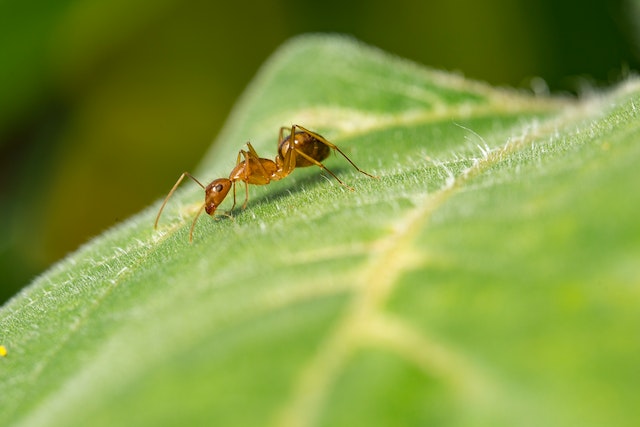
Too busy to read? Watch on YouTube
Are ants and termites the same thing? No. They belong to different insect orders. Termites are from the Isoptera order and ants are from the Hymenoptera order. Termites and ants are easily confused and they have a lot of similarities, but they have a lot of differences as well.
“Termite” and “ant” are very broad terms because those labels cover a huge number of insects. There are 2,972 known species of termite and 22,000 known species of ant. Termites range in size from a few millimeters in length to the Macrotermes bellicosus queen, which is over 10 cm in length (although 90% of it is basically a giant egg sac). Ants also range from a few mm long to the Bull Ant, which is about 4 cm in length.
Let’s look at the similarities between ants and termites first. They both have six legs and resemble each other at a distance. They both live in nests and they have carefully defined social hierarchies. They both have a queen that is responsible for laying all of the eggs and making sure the colony doesn’t die out. Some of them can fly and some of them bite humans. And that is pretty much where the similarities end. There are many more differences.
Ants and termites are a different shape. Ants have a narrow waist between their thorax and their abdomen and termites don’t have this. The end of an ant’s abdomen is pointed and a termite has a blunt ending. Ants have antennae that have a joint in the middle but termite antennae are made of tiny connected segments. Their coloring is very different as well. Most ants are black or brown, but most termites tend to be pale. The worker termites very rarely come out of the ground, so they don’t need any color. Ants forage for food above ground all the time, so they need to blend in with the background. For this reason, worker termites don’t have eyes, while ants do. Termites don’t need to see because there is no light where they are. To compensate, their antennae can touch, taste, detect odors, heat, and vibration. This being said, the termites that go above ground are darker and can detect some light.
The termites that go above ground are the termites charged with making new colonies. These termites have wings and can fly. Ants also do the same thing and in the right season flying ants and flying termites can be a nuisance. The wings are another way to tell the difference between ants and termites because termites have two sets of wings that are of equal length and they are much longer than the termite’s body. When they are at rest, they stick out behind the termite. Ants also have two sets of wings, but the front wings are shorter than the rear ones, and they are not much longer than the ant’s body. Termite wings are not very strong and often fall off. If you see wings on the ground, they are probably from a termite.
The things that they eat are another difference. Ants are scavengers and will eat pretty much anything. Termites live on dead plant matter, and they have bacteria living in their guts that allow them to break down cellulose. For this reason, termites cause a lot of damage to property because they eat the wood. Ants may be found living in cracks in wooden structures, but they can’t eat the wood.
The nests that ants and termites live in are also generally different. Ants dig passages underground and they carry all of the earth they dig up out of the tunnels and they pile it at the entrance to the nest. That is why an ant’s nest is usually described as an ant hill. Ant’s nests are very smooth, incredibly neat, and fairly soft. Termite nests are much harder. As termites burrow to make their nests, they combine the soil with water and their saliva to make small balls. They stick these balls to the sides of the tunnels. The water lets them shape the soil and the saliva is a kind of glue that sticks the soil together and sticks the balls to the surface of the tunnels. When the balls are exposed to the sun, the saliva dries and sets, making the outside of termite mounds extremely hard and giving them a high level of protection. The inside remains moist, protecting the termites from the sun and stopping them from drying out.
Another difference between ants and termites is that ants quite often eat termites. Many animals eat ants and termites, but one of the largest consumers of termites is ants. They can break into the termite mounds and carry off termites as food. Some ants even capture live termites and force them back to the ant’s nest to be kept as a food source for later. Ants can also be found living in abandoned termite nests as well. And this is what I learned today.
Photo by Jimmy Chan: https://www.pexels.com/photo/red-ant-on-green-leaf-2415291/
Sources
https://en.wikipedia.org/wiki/Termite
https://www.thespruce.com/difference-between-ants-and-termites-2656329
https://australian.museum/learn/animals/insects/what-are-the-differences-between-ants-and-termites/
https://en.wikipedia.org/wiki/Ant
